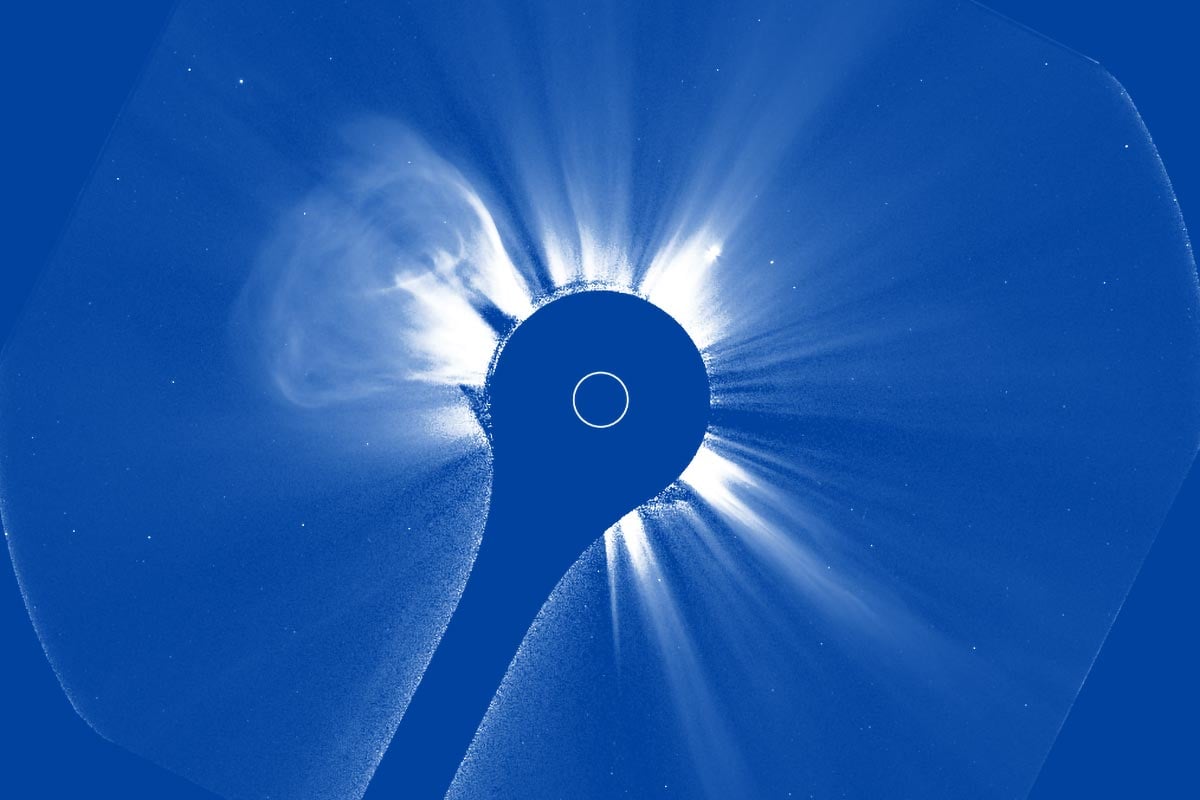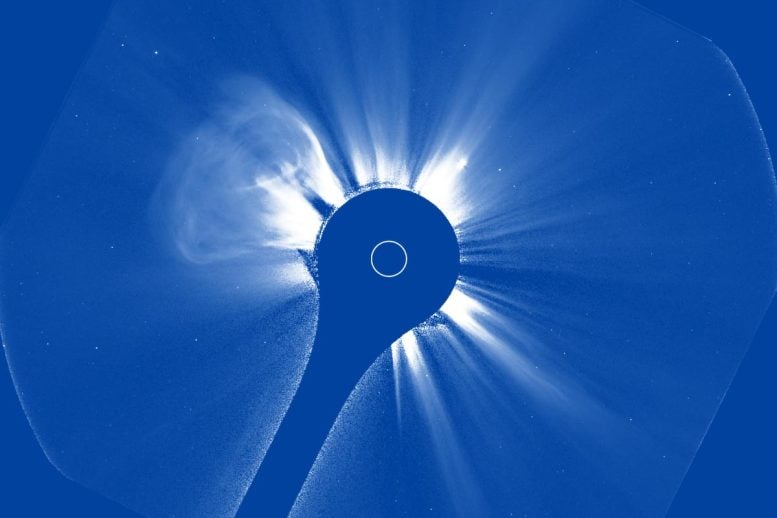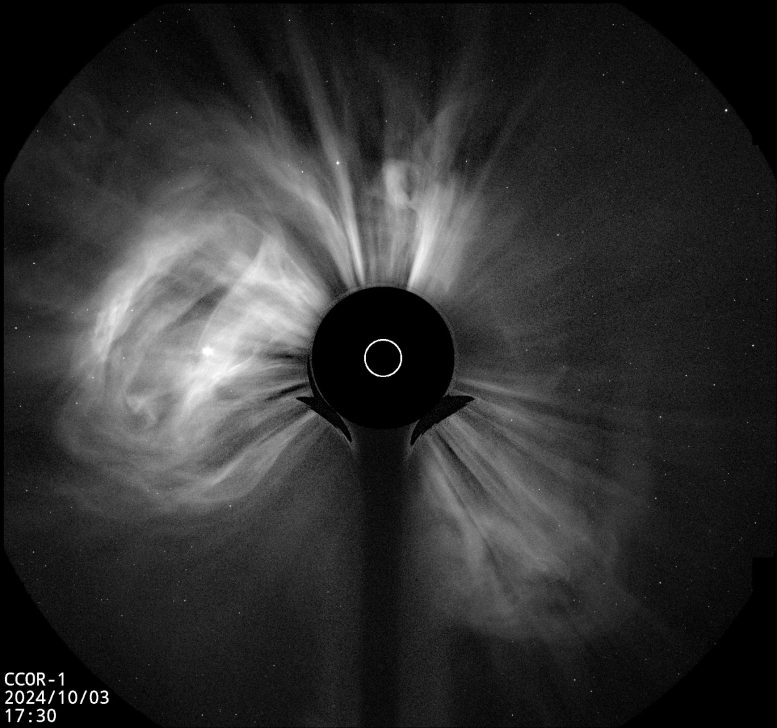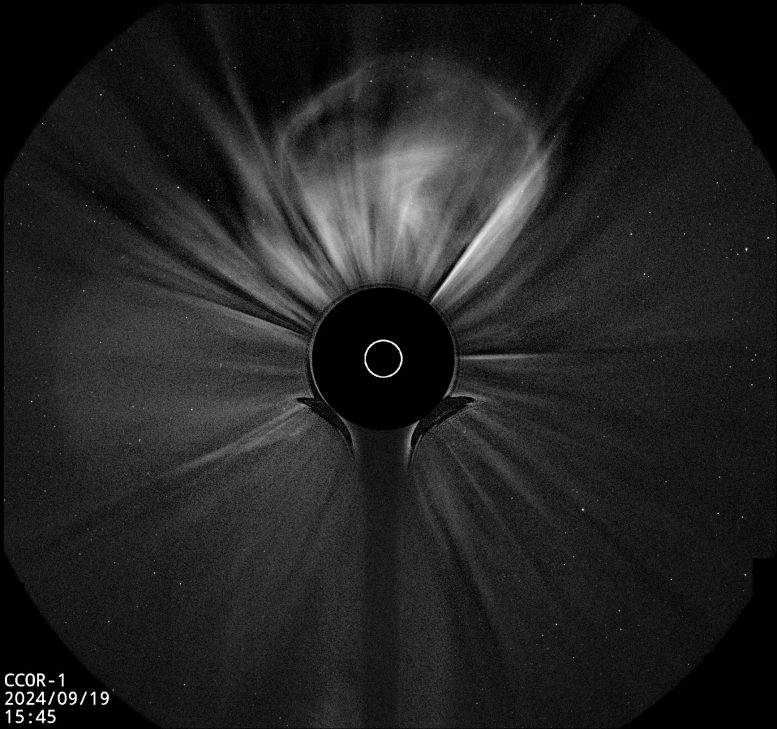

NRL’s Compact Coronagraph on NOAA’s GOES-19 spacecraft has started capturing crucial images of the Sun’s atmosphere and solar phenomena, aiding in the prediction of space weather effects on Earth.
The U.S. Naval Research Laboratory’s (NRL) Compact Coronagraph (CCOR) has successfully captured its first images of coronal mass ejections (CMEs).
The CCOR is a small space telescope specifically designed to observe the Sun’s outer atmosphere. On September 19, its aperture door was opened for the first time since the instrument was launched aboard the National Oceanic and Atmospheric Administration’s (NOAA) GOES-19 spacecraft on June 25 from NASA’s Kennedy Space Center.

Observing the Sun’s Outer Atmosphere
When the sunlight illuminated the inside of the instrument, a central cylindrical device called an occulter blocked the Sun’s disk, creating an artificial eclipse—similar to how the Moon blocks the Sun during a natural eclipse. This allows the CCOR to focus on the solar corona, the Sun’s outer atmosphere, explained Arnaud Thernisien, a research physicist at NRL’s Advanced Sensor Technology Section in the Space Science Division.
On October 3, the CCOR saw a perfect illustration of the Sun’s activity called a halo. Halos appear on coronagraph images as near-circular shapes, approximately concentric with the Sun’s center. The observed halo CME resulted in some effects seen on Earth a few days later including a rare glimpse of northern lights visible across the northern United States from Washington state to Maine. Northern lights, also called auroras, are the result of Earth’s magnetosphere disturbance with solar wind.

Continuous Monitoring and Future Developments
Over the next few weeks, the CCOR witnessed several CMEs including another halo on Oct. 10, resulting from an active region at the surface of the sun. “Halo CMEs are of particular interest for space weather as they are generally directed towards Earth,” Thernisien said.
“By creating an artificial eclipse, the CCOR allows scientists to study the Sun’s corona, which can produce powerful solar storms that can disrupt Earth-based technologies,” said Thernisien. “The CCOR team is thrilled to see that the instrument is performing as expected.”
Role in Space Weather Prediction
The instrument is used by NOAA’s Space Weather Prediction Center (SWPC) and DOD to detect CMEs with low latency, providing critical early warnings of solar storms. CMEs can have severe consequences, including damage to satellites, disruptions to radio communications, and power grid failures.
This first CCOR-1 video shows a clearly defined CME emerging from the east limb (left side) of the sun around the 10:00 time mark, with Universal Time (UT) shown at the lower left. The sun also dazzles with its small and large streamers, bright radial structures along which the solar plasma travels steadily outward. The CME explosions bend and sometimes disrupt the streaming plasma, buzzing past it at speeds of hundreds to thousands of miles per second. Credit: NOAA/NASA
Expansion and Long-Term Goals
NRL’s CCOR is the nation’s first operational coronagraph. Operational means that the instrument is tailored to provide low-latency observations of the corona and has some resilience to radiation-induced space weather effects.
CCOR is just the beginning of a series of operational coronagraphs that NRL is developing for NOAA. A second instrument, CCOR-2, is scheduled for launch in mid-2025. Additionally, NRL is working on a compact coronagraph for the European Space Agency’s Vigil mission, which is scheduled for launch in 2031.
“The NRL team, in collaboration with the NOAA-NASA GOES Team, will continue testing the capabilities of CCOR-1 in space up until the end of January 2025 when it will be handed over to NOAA,” Thernisien said. “NRL would like to thank NOAA-NASA’s Office of Space Weather Observations and the Office of Naval Research for their support.”